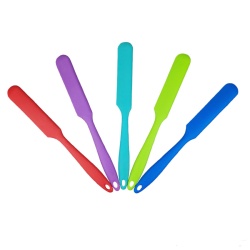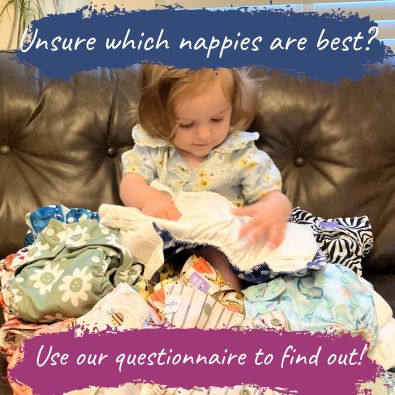How To Clean Poo Off Reusable Nappies
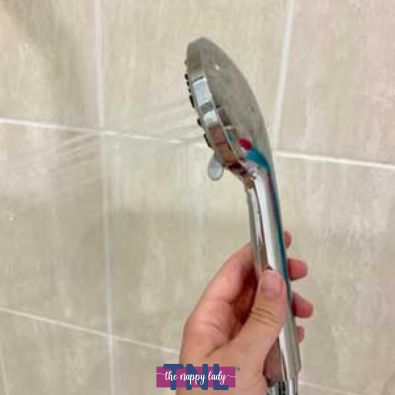
Switching to reusable nappies not only benefits the environment by reducing waste, but also saves you money in the long run. However, proper cleaning is essential to ensure their effectiveness and longevity. Fret not, we’ve got you covered with practical tips and techniques on how to clean poo off reusable nappies effortlessly!
One of the most frequent questions I get asked when it comes to cloth nappies is “but what do you do with the poo? Isn't it disgusting handling it?” No matter how much the thought of poo initially grosses you out one you're a parent you'll just get on with it regardless of whatever nappies you use. Dealing with poo is an daily (multi daily) occurrence. However in case this is my first article you're reading did you know by using reusable nappies could mean you deal with less poo? I'm sure you're thinking right..... but reusable nappies offer far superior containment than disposables so poonamis are a thing of the past.
Sometimes dealing with poo with cloth nappies is totally easy however there will be times when it can be nasty weaning, illness and teething. I'll try to explain in this article what methods you have for cleaning dirty nappies.
Firstly do you need to get rid of poo in a cloth nappy?
You will need to remove any poo on your washable nappy or reusable liner into the toilet before storing until wash day. If it doesn't shake off easily this article will give you the answers on what to do. Note that pre-weaning any kind of rinsing doesn't HAVE to be done as newborn poo is water soluble . For many people however the thought of leaving poo on the nappy and putting it all in their washing machine is too much, if this is you just remove it as you would a weaned child .
It is important that any poo goes down the toilet where it belongs and not in the bin. This is also true for disposable nappies but disposable companies don't make this clear, I wonder why...?
The Essential Guide to Removing Poo from Cloth Diapers
When it comes to keeping cloth nappies in good shape, having multiple methods is the way to go. Starting with getting rid of solid waste by shaking and then flushing or rinsing for maximum effect. These strategies will help ensure a hygienic end result.
If it doesn't budge there are three ways you can remove the poo.
Rinsing Techniques for Stubborn Messes
Bidet Spray - Using a handheld shower head or bidet attachment near the toilet: position the soiled nappy over it. Spray until thoroughly rinsed out and solid waste sprayed off. If there is any stubborn poo you could use some toilet paper for the last bits.
If you don't have a bidet an alternative is a pressurised water bottle. Just like the bidet hose you can hold your nappy over the toilet and spray the poo off with the bottle.

Poo Knife - A dedicated poo knife for scraping off solids directly into the toilet bowl for simple clean-ups. This a specific knife or spatula (i'd recommend you label it) you keep in your bathroom, to use to scrape off the poo into the toilet. I find that once you start lifting the poo with the spatula it often peels away easily.
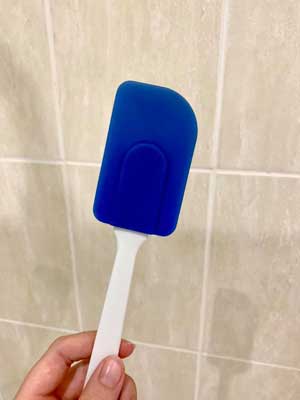
Sluicing -The toilet flush is the most effective way of rinsing off any poo and the method I have always used. This method can be used with an entire nappy or just a liner. For especially good for liquidy diapers, hold onto a clean corner of the nappy while dipping it inside a clean toilet bowl. Flush the toilet while holding onto the nappy firmly. The power of the flush will help remove solids.
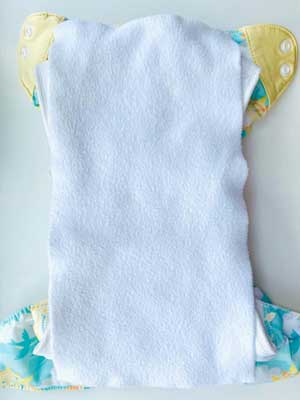
Poo Removal Tips From Nappy Lady Customers
- Fleece liners! With my first I had a scraping knife but with my second I’ve discovered the miracle of running the liner under the flush, then use a bit of loo roll if there’s any clingy bits but that’s rare really!
- Definitely disposable liners. Now they're starting to get a bit harder/formed, I'd be happier just plopping it into the toilet.
- A poo knife, and changing asap so they don't sit in it and squash it too much. And a balanced diet without too much fibre, so it's not too squishy/runny.
- Just leave tricky ones for a little while, and the nappy should absorb the wetness and the poo should then peel/roll away nicely into the toilet.
- Our toilet is next to our bath, so we would use the showerhead from the bath taps to blast it off. This is also helpful for sick buckets.
- Powerful shower head over a bucket in the bathroom then flushed down the loo… (not straight down the drain in the shower as this leads to unpleasant consequences- lessons learned.
- Butter knife or shatula for poop scraping - lived in the toilet brush holder
Can you rinse nappies in your sink?
I'm really not a fan of this method from a hygiene perspective. In theory there's no reason you can not rinse your cloth nappies in the sink, however I still would get any large bits off first. If you do use this method you must ensure you thoroughly clean your sink afterwards to ensure it is hygienically clean.
Handling Newborn and Runny Nappies
In theory if your baby is purely breastfed their poo is water soluble so you could leave the poo on the nappy and let the washing machine wash it away. However rinsing the nappy before placing it into the nappy bucket or wet bag is always our recommendation as this helps avoid staining and is better for the longevity of the nappy material.
Soaking cloth nappies isn’t usually necessary and could even be detrimental if done incorrectly.
Do you need to change your nappy washing routine when you start weaning your baby on to solid food?
You DON’T need to change the details of your routine such as frequency of your wash, the detergent amount, or what machine cycles you use.
You DO however need to start removing the poo from the nappies before they go in the machine. Once baby starts taking in solids their poo is no longer water soluble and you don’t want it clogging your machine!
You are aiming to remove as much as possible from the surface of the nappy. Some people find switching to disposable liners makes this task more manageable, some people find fleece liners easier. For any poo that doesn’t “plop” off the nappy or liner, consider a dedicated knife/spoon/shatula, or whether you can use the toilet flush, or a bucket and shower head to your advantage!
Do i need to soak cloth nappies with poo on?
Soaking modern reusable nappies in a nappy bucket is not necessary, even if there is poo or staining. Soaking nappies only creates smelling, horrid water you need to deal with and could shorten the life of your nappies.
Rinsing off as much as you can in the toilet, making sure you have a good washing routine, with decent washing powder, the correct amount of powder and a long hot wash you will not come up against stains or smells.
Selecting the Right Nappy Liners for Easy Clean-Up
When changing a nappy, liners can make the task much easier. Paper and fleece liners are the most common options used.
The paper liner is ideal for removing weaning poo as it’s stickier than usual. Paper liners are disposable and are thrown away. Bambinex paper liners are the most popular and are suitable for all ages and styles of nappies.
Fleece liners on the other hand give more protection against stains and keep baby feeling drier. However fleece liners are not disposable and need the poo removing from them as above before they can be washed. Lots of nappies such as pocket nappies and all in ones have this built in. If you're using a two part system these don't always have a built in liner so you will need to add a liner no matter your age of baby. The Bumble nappy and Motherease Sandys Dry are examples of two part nappies that have fully built in liners.
Do disposable liners make getting rid of the poo any easier? Do I need even DISPOSABLES liners in a washable nappy?
Many parents like to add a disposable liner on top of their fleece liner or nappy to help them deal with the poo. This is not really necessary but if you prefer the double liner method there is no reason why not. I regularly used this method of childcare.
Years ago you used to be able to flush disposable liners down the toilet however this is no longer recommended as they break down slower than toilet paper so there is a risk of causing blockages. Disposable liners now need to be binned which does remove some of the ease they offered over fleece liners.
A note of disposable liners. If you have just wet liners some brands can actually be washed and reused making them even more cost effective. At their end of their life wet only (not pooey ones) can also be composted.
Effective Storage Solutions for Soiled Nappies
It is crucial for keeping your house clean and odourless until wash day to store used nappies properly.
Wet bags and nappy buckets are the main options for keeping soiled diapers secure until it’s time to launder them. Both are easily emptied on laundry day directly into your washing machine.
Mastering the Pre-Wash Routine
Washing cloth nappies is easy. To keep reusable nappies clean, setting a regular wash routine is essential.
Even if you have thoroughly removed poo from your nappie, run a cold rinse cycle or quick wash cycle before your main nappy wash. The rinse cycle removes any remaining urine or poo so that the nappies are washing in cleaner water in the main wash.
You do not need to add detergent in this rinse cycle but you can if you prefer. This extra rinse cycle is just like previous generations pre-soaking nappies in a bucket but instead the washing machine is doing the hard work for you.
For best results, cloth nappies must be laundered at least every 48 hours.
Washing Nappies: Dos and Don'ts
When it comes to laundering cloth nappies, there are some essential tips that can ensure their cleanliness and longevity. When you wash nappies stick with non-bio powder detergent then wash up to 60 degrees Celsius as per the instructions found on each type of nappy label or packaging.
It’s best not to use fabric softener, two-in-one washing powders as these reduce absorbency for nappies!
Drying Strategies for Cloth Nappies Post-Wash
The correct drying techniques are essential to protecting the quality of cloth nappies.
Nappies can be air dried, put on a rack inside or an airing cupboard or - in cases when appropriate - placed in a tumble dryer on low. But putting them directly onto radiators may harm fibres or even burn the nappy. For longevity is is best if they're left out to air dry.
Maintaining Your Washing Machine's Hygiene
Will washing reusabley nappies make my washine machine dirty?
Washing nappies will not make your washing machine dirty nor will it effect anything else you wash in your machine. However, it is good to run a cleaning cycle once a month.
To clean your washing machine while using cloth nappies simply put it on an empty wash at 90 degrees with no washing powder. You can add in a cup of washing machine descaler to the drum before. This will help any build up of limescale in the pipes.
It is essential to clean your washing machine regularly, in order to prevent any grime or bacteria from accumulating. This is important to regularly do even if you are not using washable nappies.
Carrying out a maintenance cycle on the appliance every month will help keep it functioning at its best. To do this, consult your manual for detailed instructions on which cycle to run and how to clean rims & seals, filters, erase lint/build-up inside the drum, etc.
By keeping your washing machine spotless, not only can it work better but also assure that all reusable nappies are washed under hygienic conditions.
Even with disposables nappies you should be putting the poo down the toilet.
Pooey disposable nappies should have the poo removed before being binned. Poo should be going in the sewage system and treated correctly. Conveniently disposable nappy companies certainly don't make this clear, if they did would move people consider cloth nappies?
What is the best nappy for poop containment.
All reusable nappies (cloth diapers for our overseas visitors) are excellent for poo containment. Reusable nappies have stronger elastic at the legs and waist compared to disposables. This strong elastic provides a snug fit therefore keeping poo inside. If you are looking for the ultimate in containment then opting for a two part nappy system with a double gusset will ensure your nappy is bomb proof.
